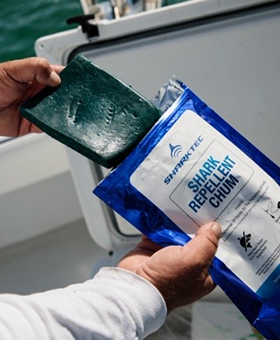Shark Repelling Science
Sharks incredible sense of smell has been well documented and serves both as a way of seeking out prey and avoiding danger. Read more about sharks and how they hunt by visiting this interactive guide
Our product is a composite of extracts from putrefied shark tissues called a “semio chemical”, or chemical signal. When released, the cloud of repellent sends a danger signal to any shark in the area indicating that a predator could be nearby, thus creating a temporary safety zone for the user.

Initial Testing
In 2001 Dr. Eric M. Stroud (SharkTec Board Member) began his qualitative analysis of semio chemical extractions on captive sharks. In 2003, with the help of Dr. Samuel Gruber, Grant Johnson and the Bimini Biological Field Station he was able to document a number of successful field tests on wild feeding sharks.
The results of these tests were presented May 26th-31st, 2004 at the Joint Meeting of Ichtyologists and Herpetologists in Norman, Oklahoma. See Research and Awards
In-depth Testing
13 field tests were conducted between 2005-2010 and the results were published in the scientific journal- Ocean and Coastal Management. The full publication can be found here

Testing Procedure
The tests were conducted at Triangle Rocks, South Bimini and the highest number of sharks present for a single trial was 12. The testing involved using chum to initiate competitively-feeding populations of Caribbean reef sharks and Blacknose sharks and then releasing the chemicals using pressurized aerosol canisters at the surface. The number of sharks in the testing area were counted at the initial, 1 min and 5 min intervals after preliminary exposure to the repellent.
Testing Results
- In both shark species, an unambiguous halt in feeding behavior was observed within 1 min after product was released resulting in 100% of the sharks to leave the area for every trial conducted.
- Sharks were not deterred by alternative control tests.
- The product induced a spectacular alarm response in interacting sharks resulting in a temporary evacuation of the area containing the feeding stimuli. The aversive behaviors were often violent, with sharks rapidly accelerating away from the chemical plume.
- With continuous bait and chum present, a limited number of sharks began to return after 10 min
- Returning sharks were always Caribbean Reef sharks; blacknose sharks did not return after chemical exposure within this period.
- The returning Caribbean Reef population was always less than half of the initial population and these sharks were noticeably disinterested in feeding. It appeared that sharks were investigating food that had fallen to the seafloor, a dramatic contrast to competitive surface feeding.
Conclusion
For all tests conducted at Triangle Rocks, South Bimini over a five year period, aversion behaviors were unambiguous and sudden, with sharks losing interest in feeding and accelerating beyond visual range within 1 min of local dispersion of the chemical.
The existence of a putative chemical shark repellent has been confirmed



